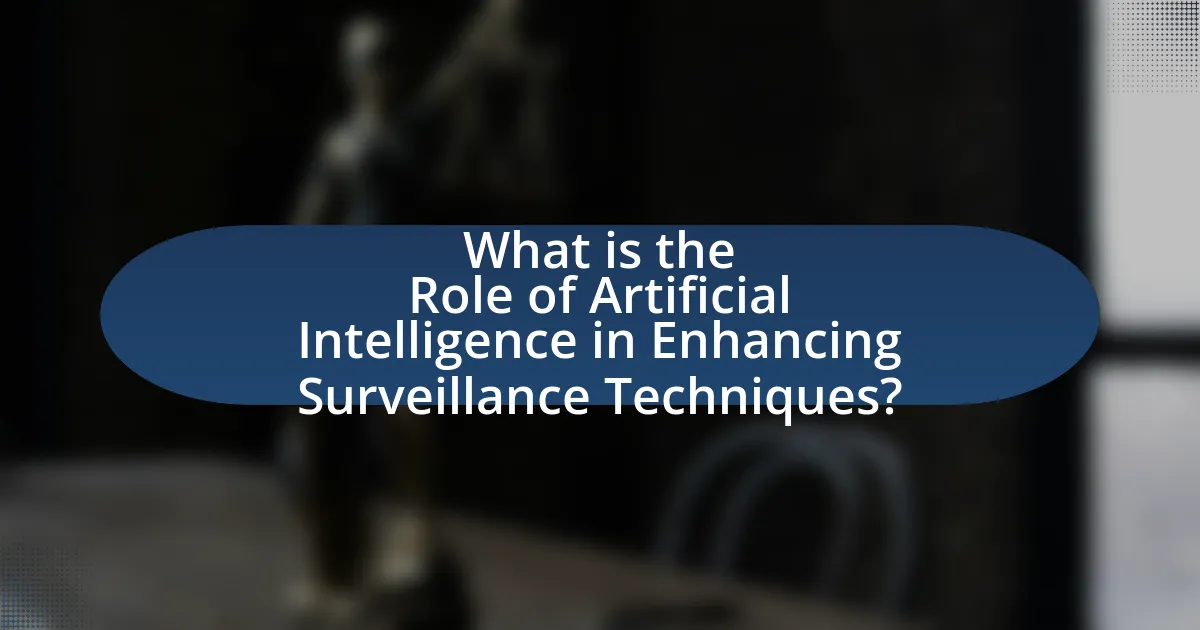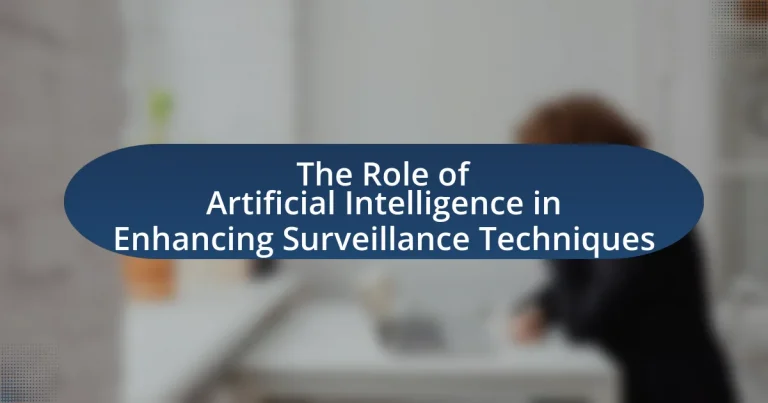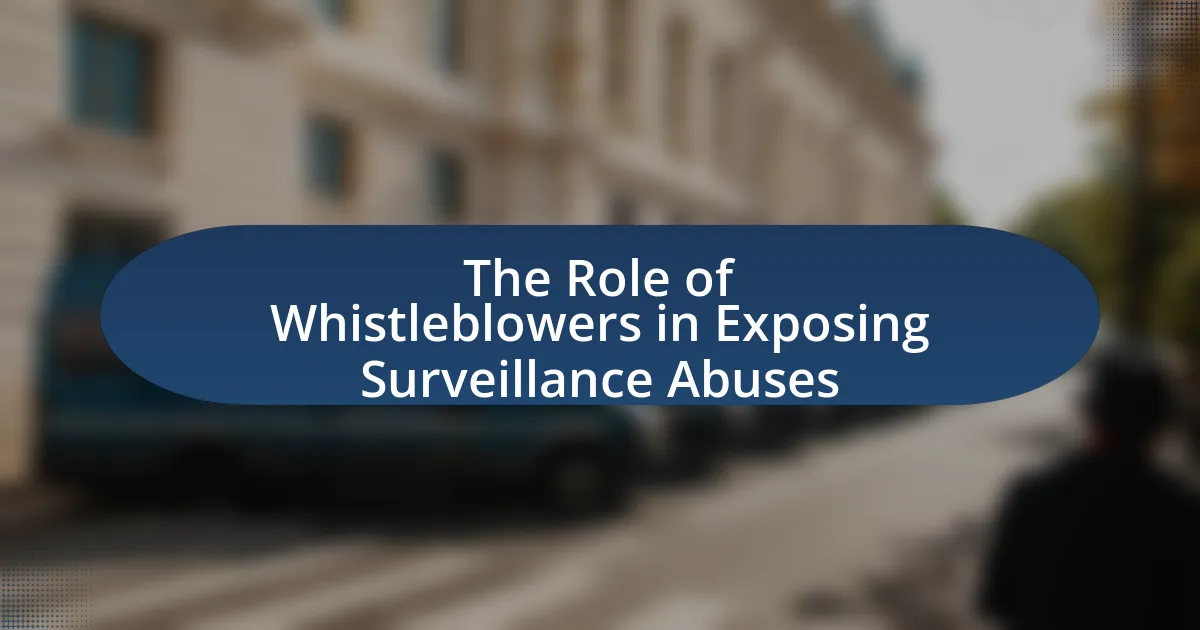The article examines the role of Artificial Intelligence (AI) in enhancing surveillance techniques, highlighting its impact on data analysis, pattern recognition, and real-time monitoring. It discusses how AI improves traditional surveillance methods through technologies such as computer vision and facial recognition, achieving accuracy rates exceeding 99%. The integration of AI into existing systems enhances efficiency and response times while raising ethical considerations regarding privacy and data misuse. Key benefits include improved detection rates and proactive threat assessment, alongside challenges such as algorithmic bias and the need for robust data security measures. The article emphasizes best practices for ethical AI deployment in surveillance, ensuring compliance with privacy regulations and effective personnel training.

What is the Role of Artificial Intelligence in Enhancing Surveillance Techniques?
Artificial Intelligence (AI) significantly enhances surveillance techniques by improving data analysis, pattern recognition, and real-time monitoring capabilities. AI algorithms can process vast amounts of data from various sources, such as cameras and sensors, enabling quicker identification of suspicious activities. For instance, AI-driven facial recognition technology has been shown to increase identification accuracy by up to 99% in controlled environments, as reported by the National Institute of Standards and Technology. Additionally, AI systems can learn from historical data to predict potential security threats, thereby allowing for proactive measures. This integration of AI into surveillance not only increases efficiency but also enhances the overall effectiveness of security operations.
How does Artificial Intelligence improve traditional surveillance methods?
Artificial Intelligence enhances traditional surveillance methods by enabling real-time data analysis and pattern recognition. AI algorithms can process vast amounts of video footage and sensor data more efficiently than human operators, identifying unusual behaviors or potential threats with greater accuracy. For instance, AI-powered facial recognition systems can match faces against databases in seconds, significantly speeding up the identification process. According to a study by the National Institute of Standards and Technology, AI-based facial recognition systems can achieve accuracy rates exceeding 99%, compared to lower rates for manual identification. This capability not only improves response times but also reduces the likelihood of human error in surveillance operations.
What specific technologies are utilized in AI-enhanced surveillance?
AI-enhanced surveillance utilizes technologies such as computer vision, machine learning algorithms, facial recognition systems, and predictive analytics. Computer vision enables the automatic interpretation of visual data from cameras, while machine learning algorithms improve the accuracy of surveillance systems by learning from data patterns. Facial recognition systems identify individuals by analyzing facial features, and predictive analytics assess potential threats by analyzing behavioral patterns. These technologies collectively enhance the effectiveness and efficiency of surveillance operations, as evidenced by their deployment in various security applications worldwide.
How do these technologies integrate with existing surveillance systems?
Artificial intelligence technologies integrate with existing surveillance systems by enhancing data analysis, improving object recognition, and enabling real-time monitoring. These integrations allow for the processing of vast amounts of video footage, identifying patterns, and detecting anomalies that human operators might miss. For instance, AI algorithms can analyze video feeds from traditional CCTV cameras, providing actionable insights and alerts based on predefined criteria. This capability is supported by studies showing that AI can increase the accuracy of facial recognition systems by up to 99%, significantly improving the effectiveness of surveillance operations.
What are the key benefits of using AI in surveillance?
The key benefits of using AI in surveillance include enhanced accuracy, real-time analysis, and improved efficiency. AI algorithms can process vast amounts of data from surveillance cameras and sensors, significantly reducing false positives in threat detection. For instance, a study by the International Journal of Information Management found that AI-based systems can improve detection rates by up to 90% compared to traditional methods. Additionally, AI enables real-time monitoring and alerts, allowing for quicker responses to incidents. This capability is crucial in public safety scenarios, where timely intervention can prevent crimes or accidents. Furthermore, AI systems can learn and adapt over time, continuously improving their performance and reducing the need for constant human oversight.
How does AI increase the accuracy of surveillance data?
AI increases the accuracy of surveillance data by utilizing advanced algorithms for real-time data analysis and pattern recognition. These algorithms can process vast amounts of visual and audio data, identifying anomalies and relevant events with higher precision than traditional methods. For instance, AI-powered systems can reduce false positives in facial recognition by up to 99% through improved image processing techniques and machine learning models trained on diverse datasets. Additionally, AI enhances data accuracy by continuously learning from new inputs, allowing for adaptive improvements in surveillance capabilities over time.
What impact does AI have on response times in surveillance operations?
AI significantly reduces response times in surveillance operations by automating threat detection and analysis. Traditional surveillance methods often rely on human operators who can be slow to identify and react to incidents, whereas AI algorithms can process vast amounts of video data in real-time, identifying anomalies or suspicious behavior within seconds. For instance, studies have shown that AI-enhanced systems can improve detection rates by up to 90%, allowing for quicker alerts and faster decision-making. This efficiency not only enhances situational awareness but also enables law enforcement and security personnel to respond more effectively to potential threats, ultimately improving public safety outcomes.
What ethical considerations arise from AI-enhanced surveillance?
AI-enhanced surveillance raises significant ethical considerations, primarily concerning privacy, consent, and potential misuse of data. The integration of AI in surveillance systems often leads to the collection of vast amounts of personal data without individuals’ explicit consent, infringing on their right to privacy. For instance, studies have shown that surveillance technologies can disproportionately target marginalized communities, leading to systemic biases and discrimination. Additionally, the potential for misuse of surveillance data by authorities or corporations poses risks of abuse, such as unwarranted tracking or profiling of individuals. These ethical dilemmas necessitate a careful examination of the balance between security and individual rights in the deployment of AI-enhanced surveillance systems.
How does AI affect privacy rights in surveillance practices?
AI significantly impacts privacy rights in surveillance practices by enabling more intrusive data collection and analysis. The integration of AI technologies, such as facial recognition and predictive analytics, allows for the continuous monitoring of individuals without their consent, raising concerns about the erosion of personal privacy. For instance, a report by the Electronic Frontier Foundation highlights that AI-driven surveillance systems can track individuals across various public spaces, leading to potential misuse of personal data and profiling. This capability challenges existing privacy laws and regulations, as traditional frameworks often struggle to address the complexities introduced by AI technologies in surveillance.
What measures can be taken to ensure ethical AI use in surveillance?
To ensure ethical AI use in surveillance, implementing strict regulatory frameworks is essential. These frameworks should include guidelines for transparency, accountability, and data protection to prevent misuse of surveillance technologies. For instance, the General Data Protection Regulation (GDPR) in Europe mandates that individuals be informed about data collection practices, thereby promoting transparency. Additionally, establishing oversight bodies can help monitor AI systems and ensure compliance with ethical standards. Research indicates that ethical AI frameworks can reduce bias and enhance public trust, as seen in studies by the AI Now Institute, which emphasize the importance of ethical considerations in AI deployment.
How is AI transforming the future of surveillance techniques?
AI is transforming the future of surveillance techniques by enabling real-time data analysis and enhancing object recognition capabilities. Advanced algorithms allow surveillance systems to process vast amounts of video footage quickly, identifying patterns and anomalies that human operators might miss. For instance, AI-powered facial recognition technology can achieve accuracy rates exceeding 99%, significantly improving the ability to identify individuals in crowded environments. Additionally, AI systems can integrate with IoT devices, creating a network of interconnected cameras and sensors that provide comprehensive situational awareness. This integration not only streamlines monitoring but also facilitates predictive analytics, allowing for proactive security measures based on behavioral patterns.
What challenges do organizations face when implementing AI in surveillance?
Organizations face several challenges when implementing AI in surveillance, including data privacy concerns, algorithmic bias, and integration with existing systems. Data privacy issues arise as AI systems often require vast amounts of personal data, leading to potential violations of privacy laws such as GDPR. Algorithmic bias can result in unfair targeting or misidentification, as AI models may reflect the biases present in their training data. Additionally, integrating AI solutions with legacy surveillance systems can be technically complex and costly, hindering effective deployment. These challenges highlight the need for careful planning and ethical considerations in the implementation of AI technologies in surveillance.
How can organizations overcome resistance to AI adoption in surveillance?
Organizations can overcome resistance to AI adoption in surveillance by implementing comprehensive training programs that educate employees on the benefits and functionalities of AI technologies. Research indicates that 70% of employees are more likely to embrace new technologies when they receive adequate training and support, which helps alleviate fears and misconceptions about AI. Additionally, organizations should engage stakeholders in discussions about ethical implications and privacy concerns, fostering transparency and trust. By addressing these concerns directly and demonstrating the effectiveness of AI through pilot programs, organizations can build confidence and encourage acceptance among employees and the public.
What are the common pitfalls in deploying AI for surveillance purposes?
Common pitfalls in deploying AI for surveillance purposes include privacy violations, algorithmic bias, and lack of transparency. Privacy violations occur when surveillance systems collect data without consent, leading to potential legal and ethical issues. Algorithmic bias can result in discriminatory practices, as AI systems may misidentify individuals based on race or gender, which has been documented in studies like the one by Buolamwini and Gebru (2018) that highlighted facial recognition inaccuracies. Lack of transparency in AI decision-making processes can erode public trust, as users may not understand how data is processed or how decisions are made, which is critical in maintaining accountability in surveillance practices.
What are the best practices for integrating AI into surveillance systems?
The best practices for integrating AI into surveillance systems include ensuring data privacy, implementing robust algorithms, and conducting regular audits. Data privacy is crucial; organizations must comply with regulations such as GDPR to protect individuals’ rights. Robust algorithms enhance accuracy in object detection and behavior analysis, which can be validated by studies showing AI’s effectiveness in reducing false positives in surveillance footage. Regular audits ensure that the AI systems are functioning as intended and adapting to new threats, as evidenced by security frameworks that recommend periodic assessments to maintain system integrity.
How can organizations ensure data security when using AI in surveillance?
Organizations can ensure data security when using AI in surveillance by implementing robust encryption protocols and access controls. These measures protect sensitive data from unauthorized access and breaches. For instance, employing end-to-end encryption ensures that data transmitted between surveillance devices and storage systems remains secure. Additionally, organizations should conduct regular security audits and vulnerability assessments to identify and mitigate potential risks. According to a report by the International Data Corporation, 60% of organizations that implemented strong data protection measures reported a significant decrease in data breaches. This demonstrates that proactive security strategies are effective in safeguarding data in AI-driven surveillance systems.
What training is necessary for personnel to effectively use AI-enhanced surveillance tools?
Personnel must undergo specialized training in data analysis, ethical considerations, and technical proficiency to effectively use AI-enhanced surveillance tools. This training includes understanding AI algorithms, recognizing patterns in data, and interpreting results accurately. Additionally, personnel should be educated on privacy laws and ethical implications to ensure responsible use of surveillance technologies. Research indicates that comprehensive training programs improve operational efficiency and reduce the risk of misuse, as highlighted in studies by the International Association of Chiefs of Police, which emphasize the importance of training in the effective deployment of advanced surveillance systems.





